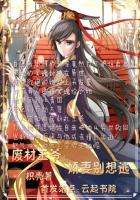In front of the house is a large pond, fed by the aqueduct that supplies the village pumps with water. Here, from half a mile and more around, come the frogs and Toads in the lovers' season. The natterjack, sometimes as large as a plate, with a narrow stripe of yellow down his back, makes his appointments here to take his bath; when the evening twilight falls, we see hopping along the edge the midwife toad, the male, who carries a cluster of eggs, the size of peppercorns, wrapped round his hindlegs: the genial paterfamilias has brought his precious packet from afar, to leave it in the water and afterwards retire under some flat stone, whence he will emit a sound like a tinkling bell. Lastly, when not croaking amid the foliage, the tree frogs indulge in the most graceful dives. And so, in May, as soon as it is dark, the pond becomes a deafening orchestra: it is impossible to talk at table, impossible to sleep. We had to remedy this by means perhaps a little too rigorous. What could we do? He who tries to sleep and cannot needs becomes ruthless.
Bolder still, the wasp has taken possession of the dwelling house.
On my door sill, in a soil of rubbish, nestles the white-banded Sphex: when I go indoors, I must be careful not to damage her burrows, not to tread upon the miner absorbed in her work. It is quite a quarter of a century since I last saw the saucy cricket hunter. When I made her acquaintance, I used to visit her at a few miles' distance: each time, it meant an expedition under the blazing August sun. Today, I find her at my door; we are intimate neighbors. The embrasure of the closed window provides an apartment of a mild temperature for the Pelopaeus [a mason wasp].
The earth-built nest is fixed against the freestone wall. To enter her home, the spider huntress uses a little hole left open by accident in the shutters. On the moldings of the Venetian blinds, a few stray mason bees build their group of cells; inside the outer shutters, left ajar, a Eumenes [a mason wasp] constructs her little earthen dome, surmounted by a short, bell-mouthed neck.
The common wasp and the Polistes [a solitary wasp] are my dinner guests: they visit my table to see if the grapes served are as ripe as they look.
Here, surely--and the list is far from complete--is a company both numerous and select, whose conversation will not fail to charm my solitude, if I succeed in drawing it out. My dear beasts of former days, my old friends, and others, more recent acquaintances, all are here, hunting, foraging, building in close proximity. Besides, should we wish to vary the scene of observation, the mountain [Ventoux] is but a few hundred steps away, with its tangle of arbutus, rock roses and arborescent heather; with its sandy spaces dear to the Bembeces; with its marly slopes exploited by different wasps and bees. And that is why, foreseeing these riches, I have abandoned the town for the village and come to Serignan to weed my turnips and water my lettuces.
Laboratories are being founded, at great expense, on our Atlantic and Mediterranean coasts, where people cut up small sea animals, of but meager interest to us; they spend a fortune on powerful microscopes, delicate dissecting instruments, engines of capture, boats, fishing crews, aquariums, to find out how the yolk of an Annelid's egg is constructed, a question whereof I have never yet been able to grasp the full importance; and they scorn the little land animal, which lives in constant touch with us, which provides universal psychology with documents of inestimable value, which too often threatens the public wealth by destroying our crops.
When shall we have an entomological laboratory for the study not of the dead insect, steeped in alcohol, but of the living insect;a laboratory having for its object the instinct, the habits, the manner of living, the work, the struggles, the propagation of that little world, with which agriculture and philosophy have most seriously to reckon?
To know thoroughly the history of the destroyer of our vines might perhaps be more important than to know how this or that nerve fiber of a Cirriped [sea animals with hair-like legs, including the barnacles and acorn shells] ends; to establish by experiment the line of demarcation between intellect and instinct; to prove, by comparing facts in the zoological progression, whether human reason be an irreducible faculty or not: all this ought surely to take precedence of the number of joints in a Crustacean's antenna.
These enormous questions would need an army of workers; and we have not one. The fashion is all for the Mollusk and the Zoophytes [plant-like sea animals, including starfishes, jellyfishes, sea anemones and sponges]. The depths of the sea are explored with many drag nets; the soil which we tread is consistently disregarded. While waiting for the fashion to change, I open my harmas laboratory of living entomology; and this laboratory shall not cost the ratepayers one farthing.















